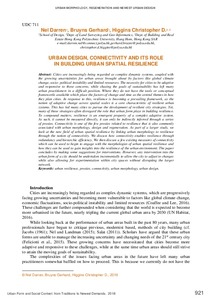URBAN DESIGN, CONNECTIVITY AND ITS ROLE IN BUILDING URBAN SPATIAL RESILIENCE
URI (для ссылок/цитирований):
https://elib.sfu-kras.ru/handle/2311/111769Автор:
Nel, Darren
Bruyns, Gerhard
Higgins, Christopher D.
(Nel, D., Bruyns, G., Higgins, C. D. : 1School of Design, 2Dept. of Land Surveying and Geo-Informatics, 3Dept. of Building and Real Estate Hong Kong Polytechnic University, Hung Hom, Hong Kong SAR e-mail:darren.nel@connect.polyu.hk,gerhard.bruyns@polyu.edu.hk, christopher.d.higgins@polyu.edu.hk)
Дата:
2019-05Proceedings of the XXV ISUF International Conference “Urban Form and Social Context: from Traditions to Newest Demands” (Krasnoyarsk, July 5–9, 2018)
Аннотация:
Cities are increasingly being regarded as complex dynamic systems, coupled with the growing uncertainties for urban areas brought about by factors like global climate change, socio- political instability and limited resources. The necessity for cities to be adaptive and responsive to these concerns, while chasing the goals of sustainability has left many urban practitioners in a difficult position. Where they do not have the tools or conceptual frameworks available which place the factors of change and time as the central themes in how they plan cities. In response to this, resilience is becoming a prevailing framework, as the notion of adaptive change across spatial scales is a core characteristic of resilient urban systems. This has led many cities to pursue the development of resilient city strategies. Yet, many of these strategies often disregard the role that urban form plays in building resilience. To compound matters, resilience is an emergent property of a complex adaptive system. As such, it cannot be measured directly, it can only be indirectly inferred through a series of proxies. Connectivity is one of the few proxies related to resilience that is also commonly associated with urban morphology, design and regeneration. As part of a larger study, we look at the new field of urban spatial resilience by linking urban morphology to resilience through the notion of connectivity. We discuss how connectivity enables resilience through redundancy and hierarchic efficiency. We then discuss a few existing measures of connectivity which can be used to begin to engage with the morphologies of urban spatial resilience and how they can be used to gain insights into the resilience of the urban environment. The paper concludes by making some suggestions for interventions. However, any intervention into the urban form of a city should be undertaken incrementally to allow the city to adjust to changes while also allowing for experimentation within city spaces without disrupting the larger network.
Коллекции:
Метаданные:
Показать полную информациюСвязанные материалы
Показаны похожие ресурсы по названию, автору или тематике.
-
URBAN TRANSFORMATION IN SEOUL AND SINGAPORE: ON THE IMPACTS OF DIGITALIZATION, MOBILITY STRATEGIES, AND URBAN GOVERNANCE
Hekler, Martina (Siberian Federal University, Сибирский федеральный университет, Красноярск, Krasnoyarsk, 2019-05)The dynamics and extent of urban transformation appear to have been very well developed by the beginning of the 21st century. It also seems that urban digitalization strategies in Asia are hardly slowed by resistance such ... -
Literature Review on the Urban Environment of Krasnoyarsk
Smolina, Maya G.; Koptseva, Natalia P.; Sertakova, Ekaterina A.; Смолина, М.Г.; Копцева, Н.П; Сертакова, Е.А. (Сибирский федеральный университет. Siberian Federal University, 2018-10)An article gives a review of the scientific literature on the urban environment in Krasnoyarsk, defines main areas of research of this topic, provides analysis of representative scientific publications reflecting the ... -
A COMPREHENSIVE VIEW ON THE EVOLUTION OF URBAN SPATIAL STRUCTURE OF THE LARGEST POST-SOVIET CITIES IN RUSSIA
Ptichnikova, G.A. (Siberian Federal University, Сибирский федеральный университет, Красноярск, Krasnoyarsk, 2019-05)The article describes the development trends of urban spatial structure of the largest Russian cities since the 1990s to the present. The author considers the urban density as a key concept in the description of a city’s ... -
Features of Urbanization: Formation and Development of Krasnoyarsk Agglomeration
Усманова, Ирина Хабибрахмановна; Лигаева, Надежда Анатольевна; Кузнецова, Ольга Анатольевна (2020)В статье рассматриваются особенности процесса урбанизации на примере формирования красноярской агломерации, целью которой является повышение эффективности экономического, социального и культурного развития Красноярского ... -
Городская художественная культура: современные концептуальные основания и методологические подходы к изучению
Ситникова, А. А.; Sitnikova, Aleksandra A. (Сибирский федеральный университет. Siberian Federal University, 2023-11)В начале XXI века одно из центральных мест в гуманитарных науках отведено урбанистическим исследованиям, которые способствуют улучшению уровня жизни в городе, созданию комфортной городской среды для жизни людей. Настоящее ...

